He’s So Unusual
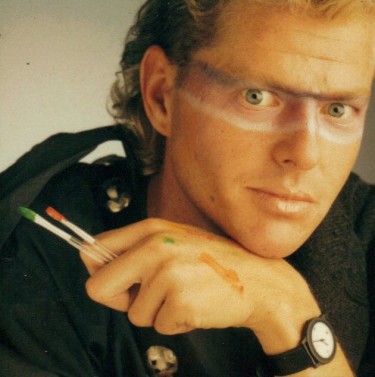
The other day at Barnes & Noble they’d just set up a new endcap display of musicians’ autobiographies. Patti Smith’s was there, Rod Stewart’s was there, and so was Cyndi’s. In my family, when you say “SIN-dee,” you’re referring to one of three people: Aunt Cindy, Aunt Cyndi, or Cyndi Lauper. The aunts haven’t written their books yet, so obviously this one was by the latter — the one my uncle helped create. Once upon a time, many careers and homes and friendships ago, Patrick, my mom’s older brother, was Cyndi’s makeup artist, hairdresser, and stylist, through her screaming rise to fame in the ’80s. Upon seeing the book, and its large typeface and double-spacing, I thought “I know her story, but let’s skim and see what she says about him.” At the end of Chapter Eight, one of many about being famous, she brings up how in the mid-’80s some of her friends began to get sick.
I saw AIDS change and then debilitate friends, like my hair and makeup artist Patrick Lucas. He’s still alive but fights all the time because the disease dosen’t make it easy and you have to take so many drugs. He once told me that the drugs are so hard that AIDS survivors say among themselves that this one or that on is dying of “old AIDS.” Patrick was a huge part of the creation of my makeup and hair in the beginning. We would come up with these ideas and he would execute them to perfection. I’d say I wanted the checkered pattern on his shirt on my eyes and he would paint checkerboards on my lids. He also colored my hair for “Money Changes Everything” when were on the road and I couldn’t go to Vidal Sassoon. He made my roots blonde and my ends red like a flame. He also did my makeup for the Rolling Stone cover. The two of us were in perfect sync. One of my eyes is shorter than the other, so I would drive him crazy about making them look the same.
And that was it. It’s a book about her, not my uncle, I know. But it did rub me the wrong way that this guy I idolized as a kid — the cute one trailing behind her on her way, say, into the WWF ring on late night television — was only brought up in the context of an illness. I called him and voiced my mini-outrage. In response, he began signing his emails “Mr. AIDS, Your AIDS Ambassador,” which is hilarious. So, I asked the good ambassador if he’d sit down for a chat to fill in the gaps. What follows is a blog-sized version of his story.
Jane: So how did you become a stylist? I don’t think I even know. I’m not even sure I know the general chronology of your life?
Well, originally, in the ’70s, I went to school in Michigan for a year to become a Special Ed teacher. And at the time I was working at a Holiday Inn and they found out I was gay and promptly fired me.
Whoa.
Which I think was legal at the time? So, I left and moved to New Orleans with a friend of a friend. I lived in The Quarter and I worked at Brennan’s, a fancy restaurant. One night, I went to a play with some friends and we were hanging out afterwards with all these actors and everyone was talking about New York and how I should go. I’d just done my first modeling job — a runway show for some buyers at a department store. Within a month, here I am, 19–20 years old, I moved to New York to be a model. I arrived with $50 in my pocket.
Oh god, you have one of those stories? Haha…
Yeah, I did! So, I started out doing in-house modeling for Halston and I would also dress the shows at Anne Klein.
What do you mean “dress the shows?”
I’d dress the models. I’d be one of 10 or 20 dressers backstage and you’re assigned a model and you dress them for the entire show and you know what they wear, what shoes, all that.
That’s exciting!
It was very exciting! Oh my god, and the models! Then, of course, I knew who they all were. Jerry Hall?! I mean, yeah, that was exciting. And in the meantime I also waited on tables at Windows on the World. And I was a potter.
You had five jobs.
I had like five people on staff and we made candleholders and vases and sugar holders for all these restaurants.
All pottery?
Yeah, like stoneware. And then I got this order and it started taking off like crazy and I was probably 21, 22 then?
[Insert a long aside involving a furrier from Munich, a surprise palm tree and patio furniture delivery, a paper plane ticket to the South of France, and a love triangle with the Count of Lower Bavaria and a German movie star.]
It was, like, so weird back then. Just giving you a little taste of that life. So anyway, I come back to Manhattan and I decide to go to school because I had done some work for GQ and Macys and Bloomingdales, modeling. And on one job, I had a really bad experience and I thought, “I can’t keep doing this.”
Modeling?
Yeah, because I just felt so ugly.
Isn’t that kind of a thing with modeling? That feeling, that’s pretty common, right?
Yeah, well, modeling fucks you up. It’s an awful thing, it really was. So I come home from this job crying, “I can’t do this.” So I decide to go to school, cosmetology school, in New York and before I’m even out of school, I get a call from a friend of a friend: there’s this photographer who wants me to help out on a shoot. And here I am, I’ve never done makeup before. I’ve done hair, but, you know…
Wait, did you not learn makeup in the school? Just hair?
Well, men couldn’t do makeup. There was some old archaic law — I’m sure it’s not on the books still — in Manhattan. You were not allowed to touch a woman below the waist, meaning no nails, and then for some reason no makeup? I don’t know. But, so they wouldn’t teach us! So I’m booked to do this shoot and I don’t find out until I’m there that it’s for Italian Bazaar, and here I am, not even out of school yet! I winged it. I just winged it, and luckily it was published, and luckily it was nice. But it turned out that the photographer, you know General Somoza of Nicaragua? It was his son. Which was like, oh! All these body guards and stuff. These were his people and it was very dicey.
What!?
So I become friendly with him.
Well, I mean, yeah. What choice did you have? Haha…
Haha, anyway, so I graduate school, and a few weeks later I get the call from Cyndi through another friend. This guy calls me and wants me to shoot for this singer. Her song hadn’t come out, nothing had come out. And they wanted me the next day.
And what did they tell you this job was?
It was for a new singer and it was for an Italian TV show called Popcorn, which was a music show. So they rented a flat and I walk in the next morning, and there’s this huge king-sized bed. And there’s Lou Albano and these other wrestlers and Cyndi and her mom. And I’m like, “Ugh, Jesus, what am I doing here? Who are these people?” And then they start playing the song, “Girls Just Wanna Have Fun,” and I’m like, “Ohhh, that’s… it.” I just knew it was gonna be a hit. So I made myself indispensable. I mean, doting, putting her shoes on, everything. I really laid it on thick because I really wanted it. Two months before that, while I was still in school, I was watching MTV one night — which was just a few years old — and I thought that’s what I really want to do. I was telling people — trying to get the word out, put out some feelers — and they were like “That’s impossible, it takes years.” And I wouldn’t hear it. People that I knew knew other artists who were just getting labels or trying to get labels, so I just thought I’d start there. But then I got the call from Cyndi.
What did you end up doing style-wise that day, do you remember?
She had pajamas on when I came in, actually, but we had the bustier and all that stuff. And the hair wasn’t as crazy as we did it later, it was just red. But yeah, she wore a bustier and a skirt. And for the next week we ended up doing a a lot of stuff, Rolling Stone did a “What’s Hot” or, you know, the “new person to watch” kind of article. And I helped her shop at Screaming Mimi’s which was a store she worked at.
What kind of store?
Used clothing, vintage stuff. She had worked there before and was friends with the owners and she’d send me there for clothes. And then I heard she was going to LA, but no one had called to ask me to come with. So I called David, her manager, and I said “I hear you’re going to LA?,” and he said they couldn’t afford to take me. I said, “Well, you NEED me. Who is going to do her hair and her makeup and her clothes?,” and he said they really can’t afford me. And I said, “What if you don’t pay me, just a ticket and a per diem?” Meanwhile, he’s working me because he knows that’s what I want to do. So, in the end, that’s what I did: went out to LA. She did American Bandstand, Solid Gold, all those things that week. And I worked my ass off, 14-hour days, and on Friday I thought we were going back to New York, but they dropped the single in Japan and it was doing incredibly well and he asked me if I wanted to go to Japan. I was like, “Yeah, but I don’t have anything with me! I don’t even have my passport here.” And he said, “It’s all taken care of; I have someone at your apartment now getting it from your roommate.” So it was a week and I was in Japan.
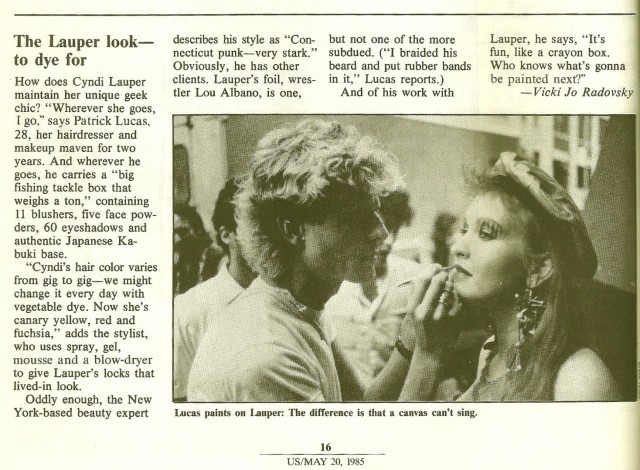
“When I went to Japan, I realized why I had caught on: My hair was bright orange, I wore funny clothes, and I had war paint on my face. Just like some of their cartoons.” — Cyndi Lauper: A Memoir
Were you still working 14-hour days?
More than that. More. Our days went like this: I would get her up around 5 A.M., get her something to eat, draw a bath, and then a radio station would call — she’d have to do radio interviews. Then get her dressed, then meet a reporter at the restaurant downstairs, get in the car where there’d be another reporter, go to a shoot, do the shoot, and near the end you try to book more reporters, then go to a TVshow… and it went like that for the first year. It was crazy. And yet, she’s not even like BIG yet! I mean, she has fans, but I remember we left Japan and stopped home on our way to Englad and she hadn’t had anyone notice her yet. I remember I went outside that day to have a cigarette and there were all these girls outside and I heard them say her name and they wanted her autograph. And that was the beginning.
One time we were in Japan — we had to go there many times — and she went to a club to make an appearance and they told us to stay together and we got midway through the dance floor and people are pulling at her. My shirt was ripped, and she’s’ screaming and then suddenly bouncers are just throwing — literally throwing — people away from her. They get us to this booth and we are near tears, just so freaked out, and then we sit down and we’re shaking and these people are smiling at us giving us the finger because they thought it was cool! A cool thing to do. That was crazy.
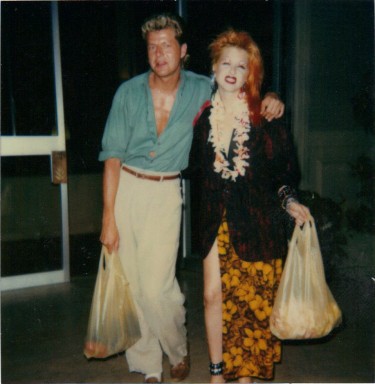
Jet-lagged in Hawaii?
Do you remember coming up with looks for her? I remember reading an interview with you where you talk about glueing construction paper shapes to her face on an airplane?
Yeah, we did that! Well, I remember we were on a shoot with Matthew Rollston and he asked “Could you put these grapes in her hair?,” and thought, ugh, tacky. And so I said, “Sure. While we’re at it, why don’t we put a big line across her face?” and he said, “Oh that’s perfect!” And I was joking. But that was the beginning of the crazy makeup, that was the original one. And then anything we’d do where she had a new outfit, I’d have it in front of me hanging on a hangar and I’d copy the design — whatever that was — onto her face.
And what about her hair?
I remember doing one I called “The Bird of Paradise.” I’d cut it like that flower with the colors to match.
Wait, so tell me about being in her video.
Oh, hmm…
Well you said that was your dream, to be on MTV…
Well, I wanted to be outside of it! So, Cyndi actually called me and asked if I’d be in the “She Bop” video and I said yes. I thought I was going to be this kangaroo ’cause I had this kangaroo jump I’d made up in Australia. And she said, “No, no, no. I want you to dress as a woman. As a nurse.” So she did my makeup and we worked 24 hours straight, exactly, on that video.
What’s the craziest look you ever did on her?
The craziest makeup I ever did on her was for the Grammys. It was her and Rodney Dangerfield presenting. It was so insane, I thought it was maybe a bit much. She looked good, but… I had taken a color down her forehead and nose and then across her face with bright, bright eyeshadow and there was this line. It got a lot of press, so I was very excited. Then I met Regina, through someone’s management or whatever, and that was really cool. That was next and it was great.
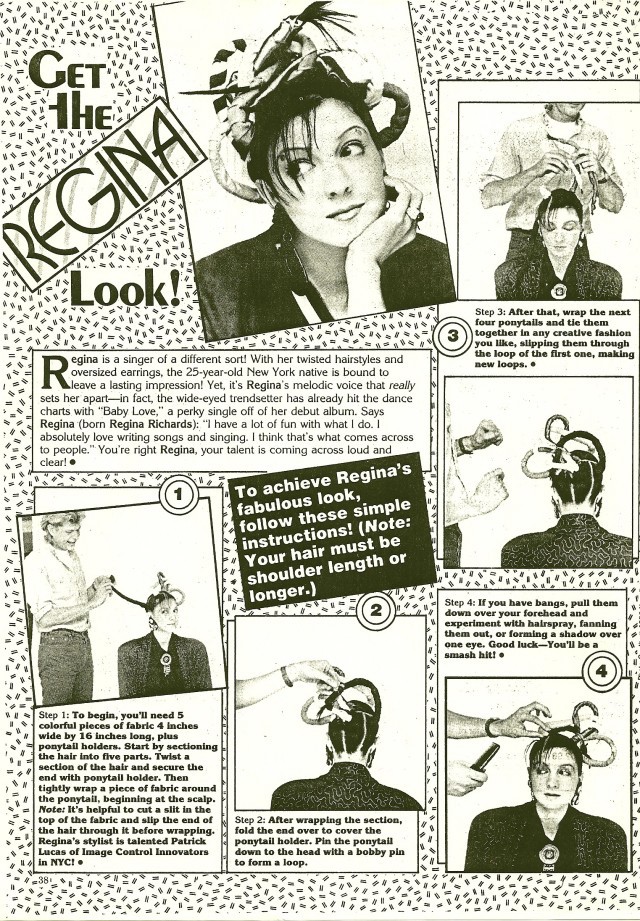
Her hair was cool.
That was great hair. But it turned out to be too much. She was getting more attention for her hair than her music, so that was a lesson.
To not make it too crazy?
You can’t upstage the act.
You can now.
You can now, yes, but not then. I didn’t know that then. You don’t want your clothes to upstage your performer and she was getting a lot more attention for her hair. And Regina was much cleaner makeup, the look was cleaner because the hair was so intense. At least that I knew not to do that, all of it at once. Also, I didn’t want to repeat what I’d done before. So, once I was with Regina, I started doing a lot of dance artists. New Shooz, Teena Marie…
So did all of this career growth coincide with getting diagnosed? And then that kind of changed your life? Was that all at one time?
Ugh, so… we were flying into Australia, and we were doing a bit for the local news, and I remember telling Cyndi when we were getting ready to do it, “I think I have AIDS.” I felt this overwhelming rush, a panic. So later I got tested, and sure enough, positive. And that day, when I got the phone call, I said “I want you to tell me, don’t’ sugarcoat it,” because they want you to come down to the office and everything and I just wanted to know right then. So he said, “You have thrush, which means you probably have AIDS, but the tests won’t be back for a day or two. And that was like a Friday. Now I get all welled up, you know? You die. And I remember I had to be be somewhere in the Village and I put my sunglasses on and I’m crying and running to a cab and some guy yells, “Fucking faggot!” And it was like, you can imagine, it just pierced my heart. I thought how perfect, the timing couldn’t have been better. So, speed up a couple of weeks, I’m on the cover of USA Today, and what is next to it? Right next to me is a headline about “AIDS.” My face, and AIDS. Oh god, was that rough. There you go, there I am, there it is.
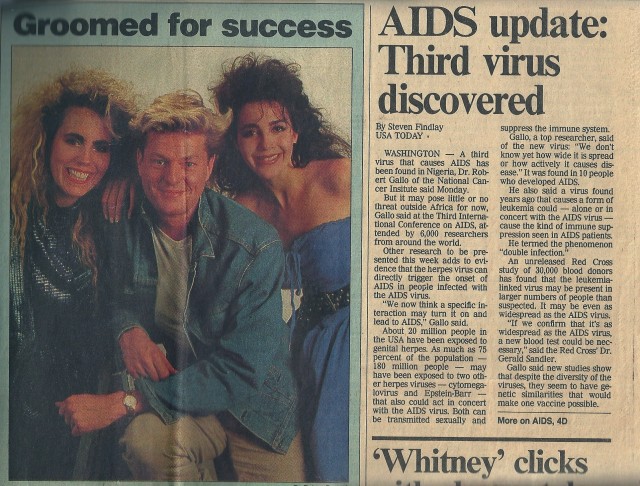
So, in the late ’80s you did makeup for a bunch of other folks, right? You did makeup on Run DMC?
Yep.
I cannot imagine those guys in makeup, but you have to wear it for every shoot, right?
Right. So, the person who normally did it for them wasn’t available I guess, so the label called me and they said, “Look, would you do this for us? It might not be easy.” And I said, “Yeah, I’ll do it.” It was for their album cover, Tougher Than Leather, and all their press photos for that. So, I remember being in the car with their two A& R people from the label and we had to go to Hollis, Queens in an entourage of five cars and we could hear rap coming from another one of their cars — I’d never heard anything so loud — and the windows were up and the car is vibrating. It was so machismo, and I’m gay and all that, it was just kind of… So we get to this typical Queens block with houses side by side and the A&R people just say, “Okay, you’re here.” I’m like, “Are you coming with me?” And they’re like, “No.” So, fine, I go upstairs, and the living room is just filled with Adidas shoes — just boxes and boxes stacked up. I get to the kitchen where I’m going to work and one of the guys says, “Who are you?” I say, “I’m here to do makeup?” And he warned me, “I don’t want to look gray, because when a white person does it, it turns out gray. And I don’t want it to look like we have makeup on. If it looks like we have makeup on, you are in…,” you know, he said some shit. So, I did it, and they were happy. I’m really good with black makeup, though. See, I used to go to Bloomingdale’s because it was the only place in Manhattan where you could mix your own powders for different shades, so I could get it just right.
Another of Patrick’s credits.
I don’t know if anyone does custom foundation right now?
Once I really understood it, my favorite thing was doing a flawless foundation. Just completely blank, you know? Really perfecting and filling each and every pore. I’d go and get different powders and I’d get a pestle and mortar and I’d use it on the powder so it would be more powdery, like talc, so it wouldn’t crease.
So wait, what did you use for shoots?
For a really heavy duty photo shoot, I started with William Tuttle’s little tubs of thick foundation. William Tuttle was a big makeup artist in the ’50s. And I would do the entire face, ears, neck.
Because it’s so heavy?
Yeah, it’s so heavy you can really see the edges. And you can’t blink, you can’t move, do not move at all, because the slightest thing will put a wrinkle in it. I’d put the foundation on and then go to each blemish. I had four different kinds of cover, one is for people who have scarring, it’s medical. I’d use that and blot those out so they’re almost white. Then I’d roll some powder on top of the blemish with the puff. Using a rolling motion, I would fill in the pores too. So then it almost looks plasticky. And that would be the starting point before I’d start on the rest of the face. Sometimes, with bigger pores, I’d take a wet Q-Tip rolled really tightly, dip it in powder, and fill each individual pore with powder, one by one.
What?! Because this was before photoshop?
Yeah, and they didn’t use airbrushing even that much.
***
Then Patrick told me about trying to invent airbrush foundation. Instead, he went on to invent a briefly buzzworthy convertible spandex dress and tube top ensemble called The Magic TUBE. I had, I think, three of them? The best color combo was black on the outside/gray and blue on the inside.
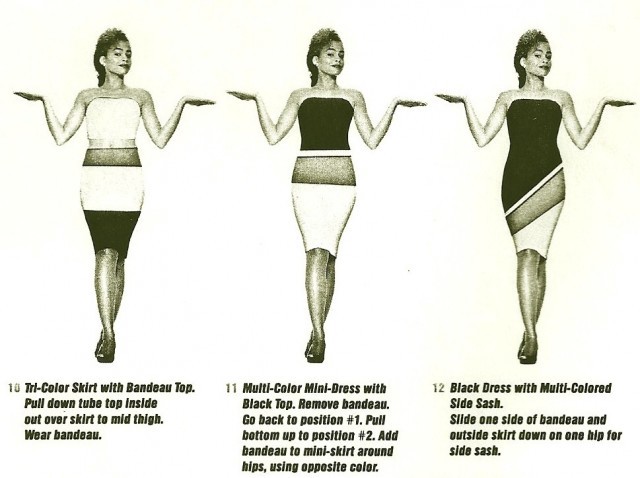
Patrick’s next endeavor was a consulting firm called Image Control Innovators, Inc. which offered up-and-coming musicians image makeovers, but that didn’t last very long. Far more disheartening than a few failed business ventures, Patrick witnessed the decimation of his entire community — the overwhelming majority of his close friends in New York had lost or were losing their battle with AIDS. He changed coasts, followed an ill-fated relationship out to Hollywood, got a job sweeping floors at a salon, and waited tables again at night.
Patrick: I didn’t have my cosmetologist license for California, so I had to get these other jobs when I got out here. And you know, of course, what happens? An A&R person from Atlantic Records comes to the restaurant. I tried to hide, but they saw me. “Is that YOU, Patrick?” Ah, talk about humbling. But the good news is, two weeks later, I’m at the salon and I’m rinsing this woman’s hair and she goes, “Patrick, it’s Judy.” And I couldn’t believe it. Judy was the producer on Cyndi’s “Goonies” video. And we hit it off from the very beginning and I hadn’t recognized her. The very next day I was doing a Chevrolet ad for MTV, and I was back. That’s all I needed. I got an agency, and it worked. I was back.
Do you remember any other standout jobs?
Yes, early on I worked with Jamie Lee Curtis. I didn’t know yet if I had what it took to work for a celebrity. You can’t be too much one way or the other: you can’t be so blasé that you don’t care, but you can’t be too excited that you make them nervous. And I remember that day Jamie was at the Four Seasons, and I came to her room, and she said, “Oh, so you’re the makeup person? Come on, get in bed, let’s watch TV.” And she ordered breakfast and we yacked for an hour, talking and eating breakfast. That was the day that I was like, okay, I think I understand this world.
Wait, what did you understand?
I understood that I made them comfortable. That I didn’t make them uncomfortable.
Patrick Lucas is a painter in Los Angeles. His latest show opens this Saturday, November 10, at Seyhoun Gallery in West Hollywood.